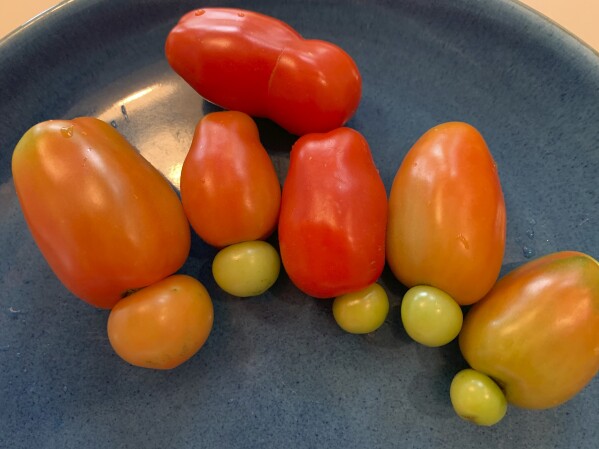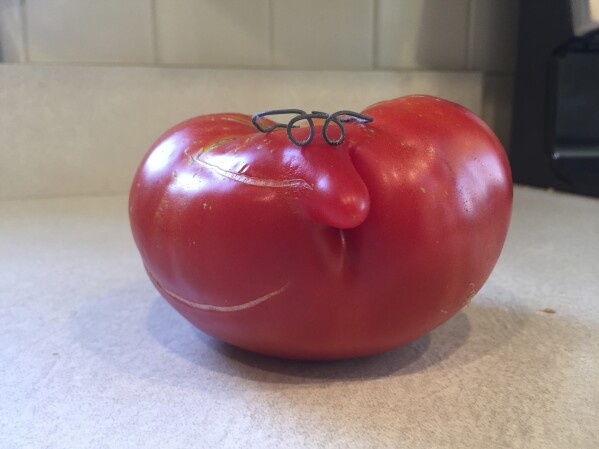This September 2021 photo provided by Richard Gill shows a tomato with a genetic mutation in North London, England. The anomaly occurs when tomato cells divide abnormally due to hot or cold weather, resulting in an extra segment that develops outside the fruit. In this case, two extra segments have developed, lending the appearance of horns.
(Richard Gill @happymrgill via AP)
BY JESSICA DAMIANO
September 12, 2023
This is the time of year when, without fail, readers send me photos of their mutant tomatoes.
Many look like Jimmy Durante (if you’re too young to know who that is, think Squidward). Others are horned, and some should carry a “for mature audiences only” warning.
The good news is there’s nothing wrong with these deformed fruits. Unless otherwise diseased, they’re perfectly edible, their taste and nutritional values unaffected. Still, those “noses,” “arms” and, um, other appendages remain an amusing curiosity.
WHAT’S GOING ON HERE?
If you’ve ever cut open a tomato, you know they are divided into internal segments, called locules, which contain gel and seeds. Most tomatoes have about 4 or 5 locules; cherry tomatoes contain 2 or 3; plum or Roma types have 2.

Tomatoes picked in a garden on Sept. 4 in Mamaroneck, New York show deformities often caused by extreme heat or other conditions. The mutations don’t affect the taste or safety of the fruits. (AP Photo/Julia Rubin)
But when a plant is exposed to temperature extremes, such as those above 90 degrees during the day and 82-85 overnight, cell division in the developing fruit could go awry, resulting in the formation of an extra locule. And because there isn’t enough room inside a tomato for an extra segment, it develops and grows outside the fruit. Cue the hilarity!

This June 10, 2018, image provided by Claudia Vos shows a tomato with genetic mutation in Aarschot, Belgium. The anomaly occurs when tomato cells divide abnormally due to hot or cold weather, resulting in an extra segment that develops outside the fruit. (Claudia Vos via AP)
Not every tomato on an affected plant will be deformed, however. “Under the right conditions (temperatures that are too hot or even too cold), this could affect one or two tomatoes per plant, depending on where they are in the development process and what the (weather) conditions are,” according to Timothy McDermott, assistant professor and extension educator at Ohio State University.
The likelihood of one of your tomatoes turning into a bona fide conversation piece is estimated to be about one in a thousand, McDermott said.

This 2022 image provided by Kathy Burrous shows a tomato with genetic mutation in Floral Park, New York. The anomaly occurs when tomato cells divide abnormally due to hot or cold weather, resulting in an extra segment that develops outside the fruit. (Kathy Burrous via AP)
When you consider how many plants are likely growing in your neighborhood alone and how many tomatoes each of those plants produce, those odds aren’t as slim as they may seem.
CAN’T GET ENOUGH WEIRD TOMATOES?
Want to increase (or decrease) your odds? It might help to know that heirloom varieties seem more susceptible to this genetic mutation than hybrids, but, of course, there are no guarantees.
The extra-locule mutation isn’t the only anomaly caused by extreme heat. Sunscald, blossom drop, halted fruit formation and ripening can also arise when plants are grown outside their ideal temperature range, which is between 70 and 85 degrees during the day.

This Aug. 7, 2020, image provided by Bill Alberigo shows a tomato with a “nose,” enhanced comically with a pair of “glasses” made from wire, in Garden City Park, NY. The mutation occurs when tomato cells divide abnormally, typically due to hot weather, resulting in an extra segment that develops outside the fruit. (Bill Alberigo via AP)
When temperatures are predicted to remain above 90 degrees for several consecutive days, providing shade for your plants will help avoid these heat-related issues. Attach a sheet of 40% to 50% shade cloth to stakes inserted into the ground around the perimeter of the bed. Leave it in place from noon to 4 p.m., when the sun is at its strongest, then remove it to avoid problems caused by insufficient sunlight, like nutrient deficiencies, scarce production or stunted fruit.
But if you still grow a tomato that looks like a duck, a devil, a celebrity or something unmentionable, send me a photo so we can share a laugh. It never gets old.
—-
Jessica Damiano writes the award-winning Weekly Dirt Newsletter and regular gardening columns for The AP.
BY JESSICA DAMIANO
September 12, 2023
This is the time of year when, without fail, readers send me photos of their mutant tomatoes.
Many look like Jimmy Durante (if you’re too young to know who that is, think Squidward). Others are horned, and some should carry a “for mature audiences only” warning.
The good news is there’s nothing wrong with these deformed fruits. Unless otherwise diseased, they’re perfectly edible, their taste and nutritional values unaffected. Still, those “noses,” “arms” and, um, other appendages remain an amusing curiosity.
WHAT’S GOING ON HERE?
If you’ve ever cut open a tomato, you know they are divided into internal segments, called locules, which contain gel and seeds. Most tomatoes have about 4 or 5 locules; cherry tomatoes contain 2 or 3; plum or Roma types have 2.
Tomatoes picked in a garden on Sept. 4 in Mamaroneck, New York show deformities often caused by extreme heat or other conditions. The mutations don’t affect the taste or safety of the fruits. (AP Photo/Julia Rubin)
But when a plant is exposed to temperature extremes, such as those above 90 degrees during the day and 82-85 overnight, cell division in the developing fruit could go awry, resulting in the formation of an extra locule. And because there isn’t enough room inside a tomato for an extra segment, it develops and grows outside the fruit. Cue the hilarity!
This June 10, 2018, image provided by Claudia Vos shows a tomato with genetic mutation in Aarschot, Belgium. The anomaly occurs when tomato cells divide abnormally due to hot or cold weather, resulting in an extra segment that develops outside the fruit. (Claudia Vos via AP)
Not every tomato on an affected plant will be deformed, however. “Under the right conditions (temperatures that are too hot or even too cold), this could affect one or two tomatoes per plant, depending on where they are in the development process and what the (weather) conditions are,” according to Timothy McDermott, assistant professor and extension educator at Ohio State University.
The likelihood of one of your tomatoes turning into a bona fide conversation piece is estimated to be about one in a thousand, McDermott said.
This 2022 image provided by Kathy Burrous shows a tomato with genetic mutation in Floral Park, New York. The anomaly occurs when tomato cells divide abnormally due to hot or cold weather, resulting in an extra segment that develops outside the fruit. (Kathy Burrous via AP)
When you consider how many plants are likely growing in your neighborhood alone and how many tomatoes each of those plants produce, those odds aren’t as slim as they may seem.
CAN’T GET ENOUGH WEIRD TOMATOES?
Want to increase (or decrease) your odds? It might help to know that heirloom varieties seem more susceptible to this genetic mutation than hybrids, but, of course, there are no guarantees.
The extra-locule mutation isn’t the only anomaly caused by extreme heat. Sunscald, blossom drop, halted fruit formation and ripening can also arise when plants are grown outside their ideal temperature range, which is between 70 and 85 degrees during the day.
This Aug. 7, 2020, image provided by Bill Alberigo shows a tomato with a “nose,” enhanced comically with a pair of “glasses” made from wire, in Garden City Park, NY. The mutation occurs when tomato cells divide abnormally, typically due to hot weather, resulting in an extra segment that develops outside the fruit. (Bill Alberigo via AP)
When temperatures are predicted to remain above 90 degrees for several consecutive days, providing shade for your plants will help avoid these heat-related issues. Attach a sheet of 40% to 50% shade cloth to stakes inserted into the ground around the perimeter of the bed. Leave it in place from noon to 4 p.m., when the sun is at its strongest, then remove it to avoid problems caused by insufficient sunlight, like nutrient deficiencies, scarce production or stunted fruit.
But if you still grow a tomato that looks like a duck, a devil, a celebrity or something unmentionable, send me a photo so we can share a laugh. It never gets old.
—-
Jessica Damiano writes the award-winning Weekly Dirt Newsletter and regular gardening columns for The AP.
No comments:
Post a Comment